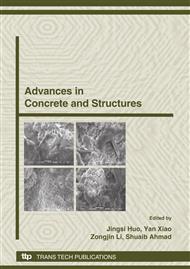[1]
P.C. Aitcin: Cement and Concrete Research Vol. 30 (2000), pp.1349-1359.
Google Scholar
[2]
K.P. Chong: Journal of Intelligent Material Systems and Structures Vol. 11 (1999), pp.892-898 Strain gauge Concrete column P PCSS 300mm 100mm 100mm 300 Strain gage S1 Strain gage S2 Strain gage S3 150 PCSS Concrete beam.
DOI: 10.1036/1097-8542.658400
Google Scholar
[3]
D. Ron: Concrete (London) Vol. 38 (2004), pp.14-15.
Google Scholar
[4]
J.S. Leng, D. Winter, R.A. Barnes, G.C. Mays and G.F. Fernando: Smart Materials and Structures Vol. 11 (2006), pp.302-308.
Google Scholar
[5]
H. De Backer, W. De Corte and P. Van Bogaert: Insight: Non-Destructive Testing and Condition Monitoring Vol. 45 (2003), pp.822-826.
DOI: 10.1784/insi.45.12.822.52987
Google Scholar
[6]
S. Park, S. Ahmad, C.B. Yun and Y. Roh: Experimental Mechanics Vol. 46 (2006), pp.609-618.
Google Scholar
[7]
W. A Li: China Safety Science Journal Vol. 15 (2005), pp.109-112.
Google Scholar
[8]
Y.S. Deng and B.J. Sun: Architecture Technology Vol. 36 (2005), pp.92-95.
Google Scholar
[9]
S.H. Wen and DDL Chung: Carbon Vol. 44 (2006), pp.1496-1502.
Google Scholar
[10]
B. Chen, K.R. Wu and W. Yao: Journal of Materials Science and Technology Vol. 20 (2004), pp.746-750.
Google Scholar
[11]
H. Li, H.G. Xiao and J.P. OU: Cement and Concrete Composites Vol. 28 (2006), pp.824-828.
Google Scholar
[12]
C.T. Li, J.S. Qian and Z.Q. Tang: China Concrete and Cement Products Vol. 2 (2005), pp.5-8.
Google Scholar
[13]
H. Li, H.G. Xiao and J.P. Ou: Cement and Concrete Research Vol. 34 (2004), pp.435-438.
Google Scholar
[14]
D.D.L. Chung: Materials Science and Engineering Vol. 22 (1998), pp.57-78.
Google Scholar
[15]
Z.Q. Shi and D.D.L. Chung: Cement and Concrete Research Vol. 29 (1999), pp.435-439.
Google Scholar
[16]
H.L. Jian: Research of the traffic weighting monitoring system based on the pressure-sensitivity of CFRC (Shantou University, China 2004).
Google Scholar
[17]
W.B. Wei: A research of the traffic vehicle-speed measuring system based on the pressure-sensitivity of CFRC (Shantou University, China 2003).
Google Scholar
[18]
L.X. Zheng, Z.Q. Li and X.H. Song: Journal of Experimental Mechanic Vol. 19 (2004), pp.206-210.
Google Scholar
[19]
S.H. Wen and D.D.L. Cement and Concrete Research Vol. 31 (2001), pp.665-667.
Google Scholar
[20]
L.X. Zheng, X.H. Song and Z.Q. Li: J. Huazhong Univ. of Sci. and Tech Vol. 32 (2004), pp.30-31.
Google Scholar
[21]
S.H. Wen and D.D.L. Chung: Carbon Vol. 44 (2006), pp.1496-1502.
Google Scholar
[22]
B.G. Han and J.P. Ou: Sensors and Actuators: A physical Vol. 138 (2007), pp.294-298.
Google Scholar
[23]
H.G. Xiao: Piezoresistivity of cement-based composite filled with nonophase materials and self-sensing smart structural system (Harbin Institute of Technology, China 2006).
Google Scholar
[24]
W. Zhang, H.C. Xie and Z. Cao: China concrete and cement products Vol. 4 (2002), pp.32-34.
Google Scholar
[25]
X.L. Fu, E.M. Ma, D.D. L Chung and W.A. Anderson: Cement and Concrete Research Vol. 27 (1997), pp.845-852.
Google Scholar
[26]
Q.Z. Mao, M.Q. Sun and P.H. Chen: Journal of wuhan university of thchnology Vol. 19 (1997), pp.65-67.
Google Scholar
[27]
S.H. Wen and D.D.L. Chung: Cement and Concrete Research Vol. 11 (2001), pp.665-667.
Google Scholar
[28]
Z.D. Guan, Z.T. Zhang and J.S. Jiao: Physical performance for inorganic material (Tsinghua University Press, China 1992).
Google Scholar
[29]
D.Z. Wo: Cyclopaedia of composite material (Chemical industry Press, China 2000).
Google Scholar
[30]
X.C. Guan, J.P. Ou, B.G. Han and H.J. Ba: Journal of Harbin University of C.E. and Architecture Vol. 35 (2002), pp.55-59.
Google Scholar
[31]
Q.Z. Mao, B.Y. Zhao, D.R. Shen and Z.Q. Li: Acta Materiae Compositae Sinica Vol. 13 (1996), pp.8-11.
Google Scholar
[32]
B. Chen, K.R. Wu and Wu Yao: Cement and Concrete Composites Vol. 26 (2004), pp.291-297.
Google Scholar
[33]
C.F. J Balta, R.K. Bayer and T.A. Ezquerra: Journal of Materials Science Vol. 23 (1998), pp.1411-1415.
Google Scholar
[34]
P.K. Pramanik, D. Khastgir, S.K. De and T.N. Saha: Journal of Materials Science Vol. 25 (1990), pp.3848-3853.
Google Scholar
[35]
B.Q. Tao and N. Wang: Electric resistance strain sensors ( National defense industry press, China 1993).
Google Scholar
[36]
B.Y. Sun: Sensor engineering (Press of DA'LIAN institute of technology, China1999).
Google Scholar


